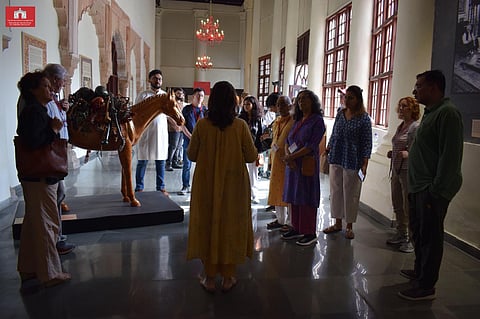

How does one ensure that what occurred as a tragedy once does not keep recurring as a macabre farce? The Partition Museum Book Club, launched in October, is, perhaps, a small step in that direction. The Partition of India was a tragic event that witnessed one of the biggest human migrations in history and large scale communal violence.
Situated within The Partition Museum in Delhi, the Book Club seeks to explore themes like displacement, borders, migration, citizenship, and community through the prism of the event, and its broader implications through literature.
Over a 100 visitors have registered as members so far. Seventy-six years on, the bad blood has, however, remained, staining individual psyches in the subcontinent. The stories, do live on in memories and materials passed down the generations.
Oral historian Aanchal Malhotra’s book, Remnants of a Separation, is a weaving of history around materials—a ghara, a maang-tikka, a pocket knife or a peacock-shaped bracelet—that were carried across the border after the split. Told from both sides of the border, it is a necessary record of recollections. The book discussion around it was the second event organised by the club, after the discussion on lyricist Gulzar’s Footprints on Zero Line.
A new bust at the museum
The discussion began with the unveiling of a bust of the artist BC Sanyal, a doyen of modernism in Indian art, who had lived through the partition of the Indian subcontinent into two. The bust was made by the late modernist sculptor Amar Nath Sehgal, one among several artists who migrated from Lahore to Delhi after 1947 and came under Sanyal’s tutelage.
“BC Sanyal gave refugee artists a sense of purpose after the trauma,” says Rajan Sehgal, the artist’s son, donating the work to the museum.
Malhotra says that there is still an “unspeakability” associated with the Partition, that people are reluctant to revisit or recount the event due to personal and collective trauma. She took a different approach.
“Objects became a catalyst to build a vocabulary around the event,” she says. Malhotra makes a distinction between the expressions of the Partition made by artists and the common person.
“Artists let out their feelings about the Partition through their artworks. For common people, there was no medium for this. They held it all within themselves and it went deeper into them, transforming into longing, sadness, bias, prejudice or confusion,” she says. “As an archaeologist of memory, I had to excavate deep.”
The book is rife with heartrending accounts. Malhotra recounts the story of a woman who used to work as a housemaid in Karachi. The woman’s husband was butchered on the train while they were travelling from Delhi to Karachi in 1947. She was pregnant at the time and since there was no way of taking her husband’s dead body with her, she pressed her chaadar in his blood and buried it in a spot in Karachi. After her daughter was born, she would take her there telling her that it was the tomb of her father.
Partition’s love stories
“The Partition is still present,” says Malhotra. “Its wounds are not shallow. They run deep.” The author is, however, against “condensing” the event to just violence. She says that people found ways of moving beyond the violence by finding new possibilities in the circumstances. Her own grandparents had met at a refugee camp in the wake of the Partition.
“There are also love stories and stories of friendships.” Having travelled to Pakistan and Bangladesh (erstwhile East Pakistan), and having met numerous people there, Malhotra states that our view of the event is limiting as it is heavily “Indocentric”. “When you work across borders, you find that Partition has a multi- generational, multi-cultural and multi-lingual existence of its own.
Sometimes you are the Other,” she says. She also stresses on how gender played a great part in how the event was experienced and recollected. She cites an instance where a woman, who was abducted during the Partition, could not speak to her because she was not permitted to do so by her son. “The son controlled how much the mother could share about her own experience,” she says.
The need for archives
Malhotra believes that oral history has as much a right to the “Truth” as do other methods of doing history. She asks why when something is written down and kept in an archive or a museum, it is considered the truth, while what one’s grandfather says about his own lived experience is not.
“We need archives to know the numbers, the statistics and the dates,” she says. “But the numbers need us. Because every number is a person.” The Partition Museum, with its artworks, objects and records of oral histories, which recall the Partition, preserves this idea of history as lived experience. “This is a people’s museum,” says Kishwar Desai, chairperson of the museum. “We present, through material memory and oral histories, how the Partition affected, and is still affecting, people.”